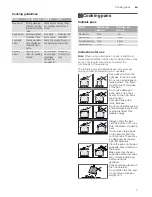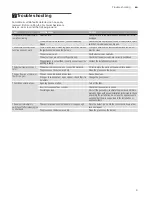
Cooking pans
en
7
Cooking guidelines
Å
Cooking pans
Cooking p
ans
Suitable pans
Instructions for use
Note:
When using certain pots or pans, a slight and
temporary deformation of the steel cooking surface may
occur. This is normal and does not affect the
functionality of the appliance.
The following recommendations can help you save
energy and avoid damaging your cookware:
Burner
Very high - High
Medium
Low
Wok burner
Boiling, steaming,
griddling, toasting,
paellas, Asian food
(wok).
Reheating and keeping things
hot: cooked and pre-cooked
dishes
Rapid burner Escalopes, steaks,
omelettes, frying
Rice, white
sauce, ragout
Steaming: fish,
vegetables
Semi-rapid
burner
Steamed potatoes,
fresh vegetables,
vegetable stews,
pasta
Reheating, keeping things hot
and making tasty casseroles
Auxiliary
burner
Cooking: casse-
roles, rice pudding,
caramel
Defrosting and
slow cooking:
vegetables,
fruit and fro-
zen products
Melting: but-
ter, chocolate,
jelly
Burner
Minimum pan
diameter
Maximum pan
diameter
Wok burner
22 cm
- cm
Rapid burner
22 cm
26 cm
Semi-rapid burner 14 cm
20 cm
Auxiliary burner
12 cm
16 cm
Use pans which are the
right size for each burner.
Do not use small pans on
large burners. The flame
must not touch the sides
of the pan.
Do not use damaged
pans, which do not sit
evenly on the hob. Pans
may tip over.
Only use pans with a
thick, flat base.
Do not cook without using
a lid and make sure the lid
is properly fitted. This
wastes energy.
Always centre the pan
over the burner, not to one
side. Otherwise it could tip
over.
Do not place large pans
on the burners near the
control knobs. These may
be damaged by the very
high temperatures.
Place the pans on the pan
supports, never directly on
the burner.
Make sure that the pan
supports and burner caps
are correctly positioned
before using the
appliance.
Pans should be placed on
the hob carefully.
Do not strike the hob and
do not place excessive
weight on it.





























